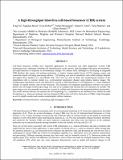| dc.contributor.author | Xu, Feng | |
| dc.contributor.author | Moon, SangJun | |
| dc.contributor.author | Hefner, Evan | |
| dc.contributor.author | Beyazoglu, Turker | |
| dc.contributor.author | Emre, Ahmet E. | |
| dc.contributor.author | Manzur, Tariq | |
| dc.contributor.author | Demirci, Utkan | |
| dc.date.accessioned | 2011-03-10T19:43:20Z | |
| dc.date.available | 2011-03-10T19:43:20Z | |
| dc.date.issued | 2010-04 | |
| dc.identifier.issn | 0277-786X | |
| dc.identifier.uri | http://hdl.handle.net/1721.1/61649 | |
| dc.description.abstract | Cell-based biosensors (CBBs) have important applications in biosecurity and rapid diagnostics. Current CBB technologies have challenges including cell immobilization on the sensors, high throughput fabrication and portability, and rapid detection of responses to environmental changes. We address these challenges by developing an integrated CBB platform that merges cell printing technology, a lensless charge-coupled device (CCD) imaging system, and custom-developed cell image processing software. Cell printing was used to immobilize cells within hydrogel droplets and pattern these droplets on a microfluidic chip. The CCD was used to detect the morphological response of the immobilized cells to external stimuli (e.g., environmental temperature change) using lensless shadow images. The morphological information can be also detected by sensing a small disturbance in cell alignment, i.e., minor alignment changes of smooth muscles cells on the biosensors. The automatic cell alignment quantification software was used to process the cell images (microscopic image was used as an example) and calculate the cell orientation in seconds. The same images were also manually processed as a control to validate and characterize the integrated platform functionality. The results showed software can measure the cell morphology (i.e., orientation) in an automated way without the need for labeling (e.g., florescent staining). Such an integrated CBB system will allow fabrication of CBBs at high throughput as well as rapidly monitor and measure morphological cellular responses. | en_US |
| dc.language.iso | en_US | |
| dc.publisher | Society of Photo-optical Instrumentation Engineers | en_US |
| dc.relation.isversionof | http://dx.doi.org/10.1117/12.852187 | en_US |
| dc.rights | Article is made available in accordance with the publisher's policy and may be subject to US copyright law. Please refer to the publisher's site for terms of use. | en_US |
| dc.source | SPIE | en_US |
| dc.title | A high-throughput label-free cell-based biosensor (CBB) system | en_US |
| dc.type | Article | en_US |
| dc.identifier.citation | Xu, Feng et al. “A high-throughput label-free cell-based biosensor (CBB) system.” Unattended Ground, Sea, and Air Sensor Technologies and Applications XII. Ed. Edward M. Carapezza. Orlando, Florida, USA: SPIE, 2010. 76931B-7. © 2010 SPIE. | en_US |
| dc.contributor.department | Harvard University--MIT Division of Health Sciences and Technology | en_US |
| dc.contributor.department | Massachusetts Institute of Technology. Department of Biological Engineering | en_US |
| dc.contributor.approver | Demirci, Utkan | |
| dc.contributor.mitauthor | Demirci, Utkan | |
| dc.contributor.mitauthor | Hefner, Evan | |
| dc.relation.journal | Proceedings of SPIE--the International Society for Optical Engineering ; v. 7693 | en_US |
| dc.eprint.version | Final published version | en_US |
| dc.type.uri | http://purl.org/eprint/type/ConferencePaper | en_US |
| dspace.orderedauthors | Xu, Feng; Moon, SangJun; Hefner, Evan; Beyazoglu, Turker; Emre, Ahmet E.; Manzur, Tariq; Demirci, Utkan | en |
| mit.license | PUBLISHER_POLICY | en_US |
| mit.metadata.status | Complete | |
